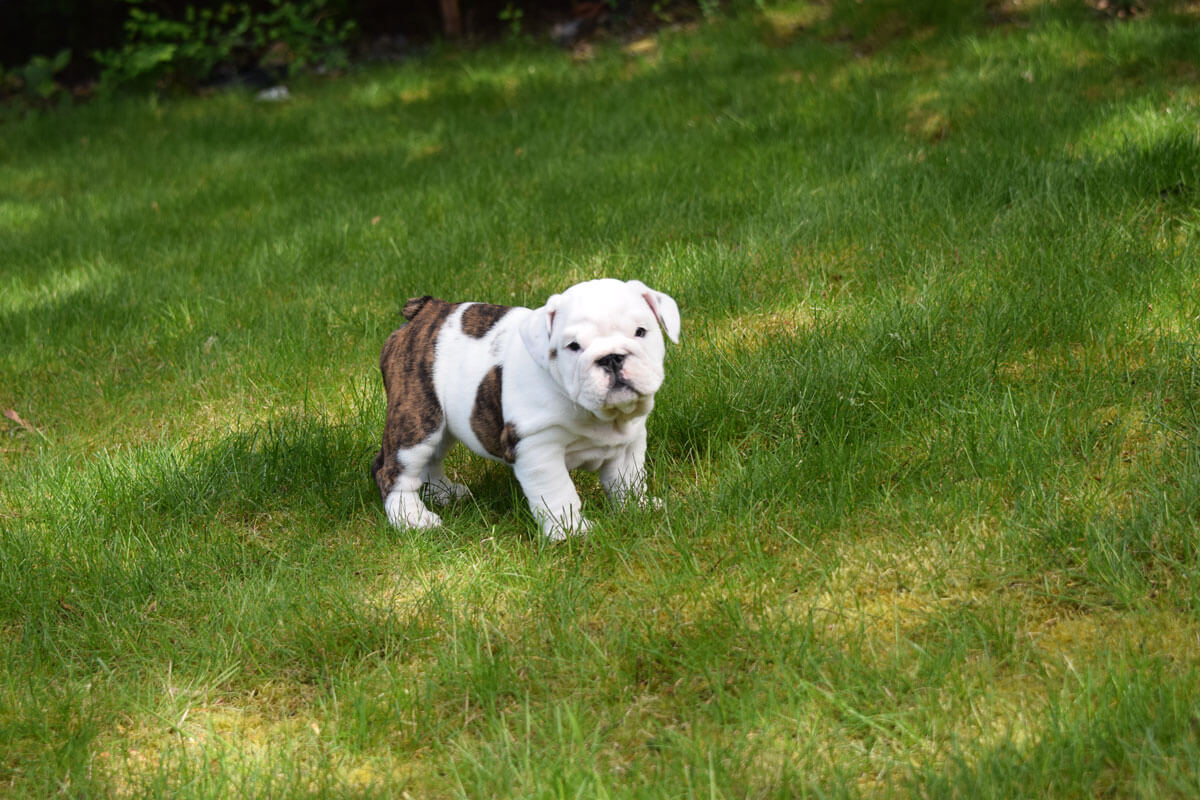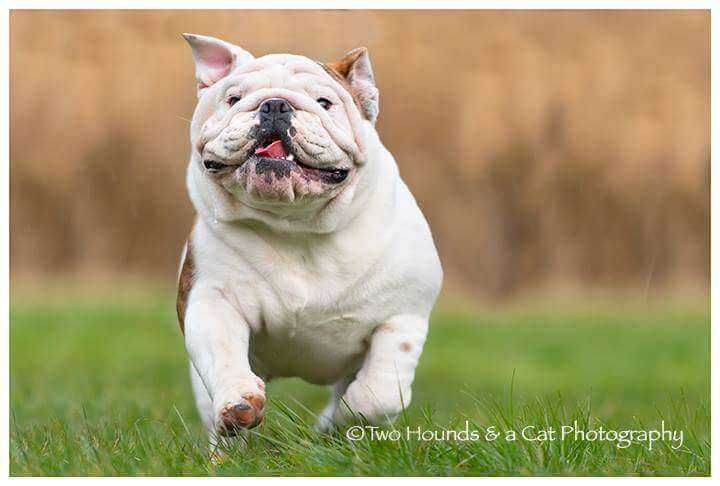Bulldogs are beloved for their stocky build, wrinkled faces, and loyal personalities—but did you know there’s more than one kind? In fact, the American Kennel Club recognizes three different types of bulldogs, each with its own unique look, temperament, and history. Whether you’re a bulldog enthusiast or considering adding one of these lovable pups to your family, it’s helpful to understand the various bulldog breeds out there.
In this guide, we’ll break down all the types of bulldogs so you can get to know these charming companions a little better.
1. The Bulldog (also referred to as the “English Bulldog”)

The Bulldog (or “English Bulldog”) is perhaps the most iconic of all bulldog types. Known for its loose, wrinkled skin, pushed-in nose, and stocky build, this breed exudes a calm and dignified demeanor. According to the American Kennel Club (AKC), the Bulldog should have a smooth coat, a heavy, thick-set, low-swung body, and a massive short-faced head. The ideal weight for mature dogs is about 50 pounds, with bitches around 40 pounds.
Origins:
The Bulldog’s origins trace back to 13th-century England, where it was bred for the brutal sport of bullbaiting—ferocious, fearless dogs pitted against bulls for public entertainment. When blood sports were outlawed in 1835, Bulldogs were crossed with terriers to create faster, more agile fighting dogs, giving rise to breeds like the Bull Terrier and Staffordshire Bull Terrier. With bullbaiting gone, the Bulldog risked extinction, but devoted breeders softened its temperament and refined its look, transforming it into the gentle, child-loving companion we know today.
Recognized by the AKC in 1886, the Bulldog has since become a national symbol of England, famously compared to Winston Churchill, and a beloved mascot for institutions like Yale University, the University of Georgia, and the U.S. Marine Corps.
Key Characteristics:
-
General Appearance: Medium-sized, with a smooth coat; heavy, thick-set, low-swung body; massive short-faced head; wide shoulders; sturdy limbs.
-
Size: Mature males weigh approximately 50 pounds; mature females about 40 pounds.
-
Head: Large skull with a broad, square appearance; prominent cheeks; deep stop; very short, broad, upward-turned muzzle; black, broad nose; thick, pendant lips; undershot jaw.
-
Eyes: Dark, round, moderate size, set low and wide apart; free from haw.
-
Ears: Small, thin, set high, wide apart, and far from the eyes; rose-shaped preferred.
-
Neck: Short, very thick, deep, strong, and well-arched at the back.
-
Topline: Slight fall behind the shoulders, rising to the loins, then curving again to the tail, forming a distinctive arch.
-
Body: Very capacious, with full sides and well-rounded ribs; deep from shoulders to lowest part; well let down between shoulders and forelegs.
-
Chest: Very broad, deep, and full.
-
Back and Loin: Short and strong; broad at shoulders; comparatively narrow at loins.
-
Tail: Short, low-set, thick at the root, with a decided downward carriage; may be straight or “screwed” (not curved or curly).
-
Forequarters: Muscular, heavy, widespread shoulders; short, stout, straight, muscular forelegs set wide apart; elbows low and well out; compact, firmly set feet with high knuckles and short stubby nails.
-
Hindquarters: Strong and muscular; longer than forelegs; slightly bent hocks; short, straight, strong lower legs; compact feet pointing outward.
-
Coat: Straight, short, flat, close, fine texture, smooth, and glossy.
-
Skin: Soft and loose, especially at the head, neck, and shoulders.
-
Wrinkles and Dewlap: Heavy wrinkles on head and face; two loose, pendulous folds at the throat forming the dewlap.
-
Color: Red, white, fawn, fallow, or any combination thereof; patterns may include brindle, piebald, ticking, black masks, black tipping, and minimal black in piebalds.
-
Gait: Loose-jointed, shuffling, sidewise motion giving a characteristic “roll”; unrestrained, free, and vigorous.
-
Temperament: Equable and kind, resolute and courageous; demeanor should be pacific and dignified.
-
Disqualifications: Blue or green eyes; brown or liver-colored nose; colors or markings not defined in the standard; merle pattern.
For a more detailed description, you can refer to the official AKC Bulldog breed standard document and read more about bulldog health and safety tips on our About Bulldogs page.
2. The French Bulldog

With their bat-like ears, charming expressions, and playful personalities, French Bulldogs (or “Frenchies”) have skyrocketed in popularity, recently becoming one of the most beloved companion breeds in the world. Despite their petite size, they carry a big-dog attitude, making them ideal for both city living and close-quarters companionship.
Origins:
The French Bulldog originated in 19th-century France, but its roots trace back to the lace workers of Nottingham, England. These artisans brought small bulldog-type dogs with them to France during the Industrial Revolution. Once in France, the breed was refined by crossing with local terriers and possibly Pugs to create a more compact, sociable dog with its now-signature upright ears. Frenchies quickly became favorites among Parisian society, artists, and café culture—earning a reputation as the “boulevardier’s companion.”
Today, the French Bulldog is celebrated for its affectionate nature, comical demeanor, and adaptability. Recognized by the AKC in 1898, it has firmly established itself as both a fashionable pet and a devoted lap dog.
Key Characteristics:
-
General Appearance: Small but muscular with a compact frame; smooth coat; trademark “bat ears” set high on the head; short nose with loose skin creating a soft facial expression.
-
Size: Typically 16-28 pounds; height around 11-12 inches at the shoulder.
-
Head: Large and square, with heavy wrinkles above a very short nose; flat between the ears.
-
Eyes: Dark, round, and expressive; set wide apart and low on the skull.
-
Ears: Large, broad at the base, rounded at the top, and standing erect—resembling bat ears.
-
Muzzle: Very short, broad, and deep; well-defined stop; black nose in all coat colors except for light fawn (where lighter shades are acceptable).
-
Body: Compact, well-rounded, and muscular; broad chest; short back with a slight roach over the loin.
-
Tail: Naturally short, either straight or screwed, but not curly; carried low.
-
Coat: Smooth, short, and fine; loose skin, particularly around the head and shoulders.
-
Color: Acceptable colors include brindle, cream, fawn, and pied (white with brindle or fawn patches); solid black, liver, and merle are disqualifications under AKC standards.
-
Gait: Free, smooth, and powerful with good reach and drive.
-
Temperament: Adaptable, affectionate, and alert; they thrive on human interaction and are generally friendly with both people and other animals.
Disqualifications: Long or curly tails; eyes of different color; merle pattern; coat colors not outlined in the breed standard such as solid black, black and tan, or liver.
3. The American Bulldog

Athletic, confident, and steadfastly loyal, the American Bulldog is a working dog at heart—with roots steeped in American farm life and frontier resilience. While not currently recognized by the AKC as a fully registered breed, the American Bulldog is acknowledged by other registries (such as the United Kennel Club) and is widely regarded as a distinct bulldog type.
Origins:
The American Bulldog descends from the original working bulldogs brought to the American South by immigrants from England in the 17th and 18th centuries. Unlike the show-focused English Bulldog, these dogs were bred for function over form—guarding property, driving cattle, and protecting families. They maintained the grit and drive of their bull-baiting ancestors, but were also selectively bred for stability and trainability.
The breed nearly disappeared by the mid-20th century, but thanks to the efforts of dedicated breeders like John D. Johnson and Alan Scott, the American Bulldog was revived. Today, two main types exist: the Johnson type (larger, more heavily built) and the Scott type (leaner and more agile), though most modern American Bulldogs are a blend of the two.
Key Characteristics:
-
General Appearance: Strong, well-balanced, and athletic; more functional and agile than the English Bulldog; slightly longer in body than in height.
-
Size: Males typically 75-100 pounds; females 60-85 pounds; height ranges from 20 to 27 inches at the shoulder.
-
Head: Broad and square, with pronounced cheeks and a deep stop; moderately short muzzle.
-
Eyes: Medium-sized, round to almond-shaped; brown preferred, but hazel and amber accepted; blue eyes or mismatched eyes are a fault in most standards.
-
Ears: Set high, may be drop, semi-prick, or rose; not cropped.
-
Muzzle: Strong and square with noticeable flews; undershot or reverse scissors bite common.
-
Body: Broad chest, strong shoulders, well-muscled back; loins slightly tucked.
-
Tail: Thick at the base and tapering to a point; carried low in a relaxed state, may curl slightly when alert.
-
Coat: Short, close-fitting, and stiff to the touch; requires minimal grooming.
-
Color: White is the base color, often with brindle, red, fawn, or brown patches; solid black and blue may be considered a fault in some registries.
-
Gait: Confident and powerful with an even, balanced stride; capable of sudden bursts of speed.
-
Temperament: Protective, loyal, and confident; generally good with children and family, but requires consistent training and socialization due to its strong guarding instincts.
Disqualifications: Varies by registry; typically includes blue eyes, solid black or blue coloration, excessive aggression, or severe structural faults.
Bulldogs may share a common ancestry and some unmistakable physical traits—like their muscular builds and endearing wrinkles—but as we’ve seen, each type of bulldog has its own distinct identity. The dignified English Bulldog, the playful and compact French Bulldog, and the athletic, working-class American Bulldog each reflect a different chapter in the breed’s evolution, shaped by their unique roles in history and the environments they were bred to thrive in.
Understanding the differences between bulldog breeds isn’t just useful for potential owners—it’s a way to appreciate the diversity and legacy of a group of dogs that have captured hearts across generations and continents.
About Cascade Bulldogs: Cascade Bulldogs is a website dedicated to educating bulldog owners on how to raise, train and show bulldogs (also commonly referred to as “English bulldogs”).
Follow Cascade Bulldogs on Facebook and Instagram for weekly updates, cute photos and inspirational bulldog quotes.
Related Posts:
- Bringing Your Bulldog Home: How to Acclimate a New Bulldog Puppy
- 5 Myths of Owning a Bulldog Puppy
- 9 Important Questions to Ask Your Bulldog Breeder











